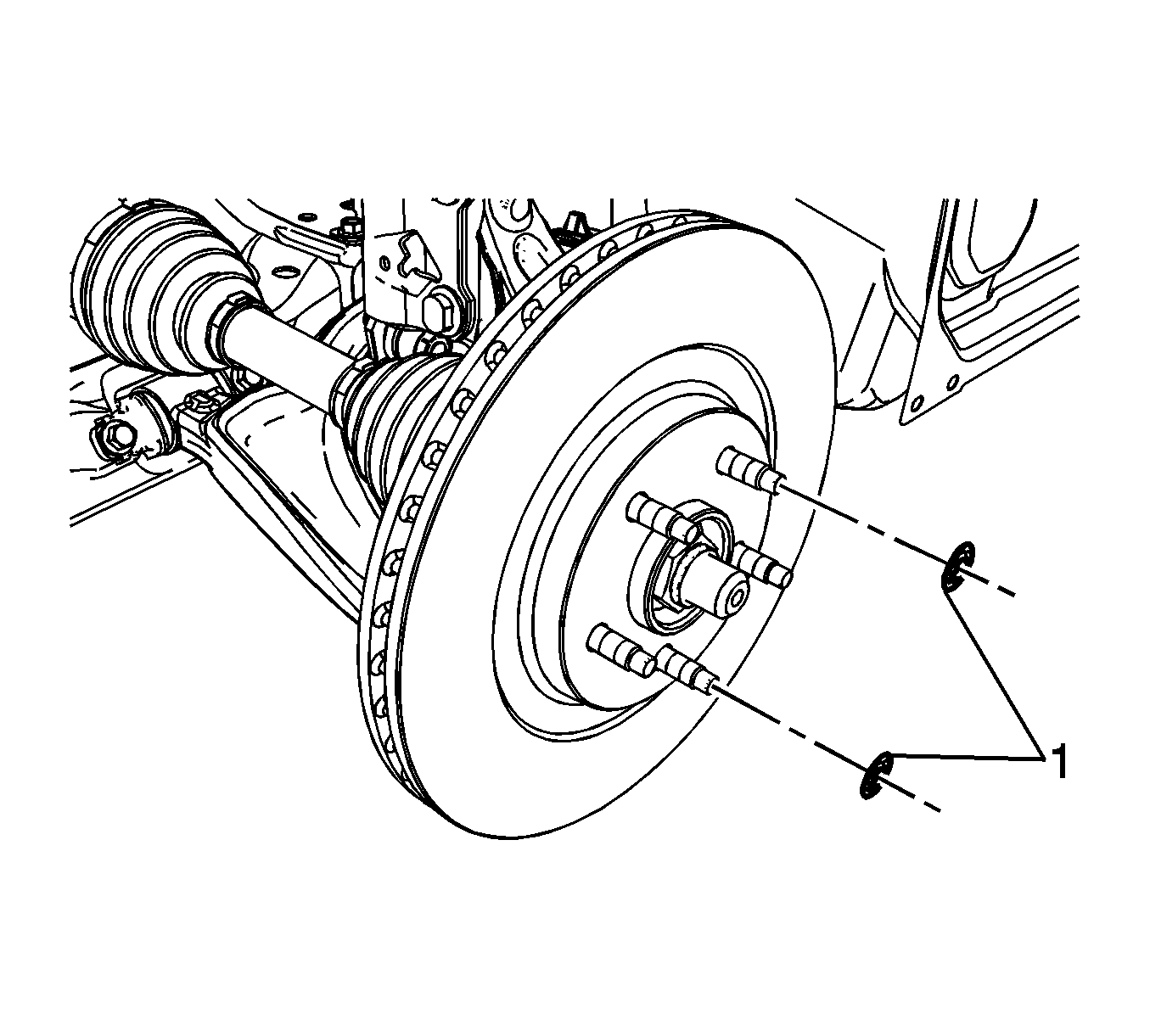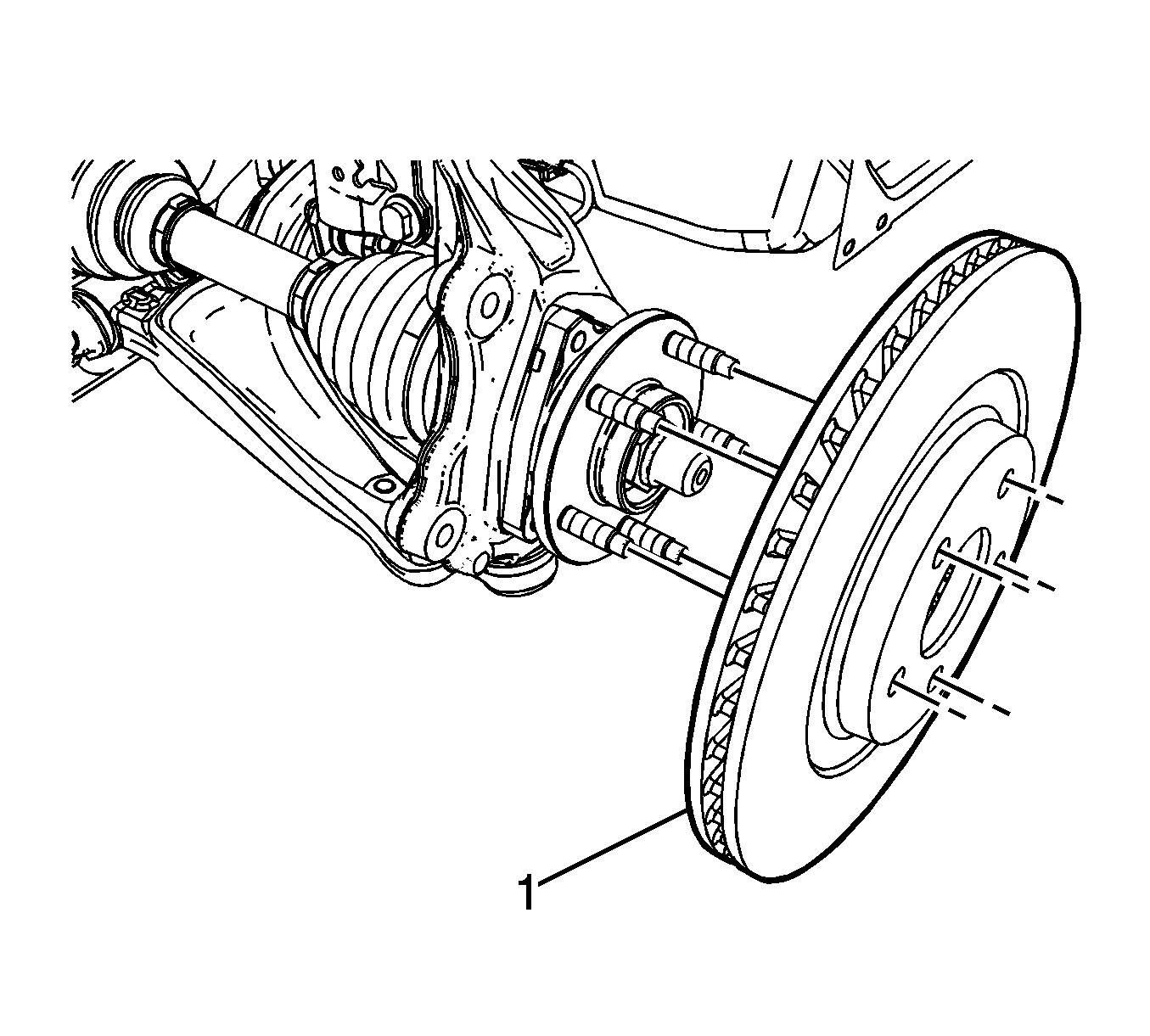Front Brake Rotor Replacement Without RPO LNF
Tools Required
| • | J 41013 Rotor Resurfacing Kit |
| • | J 42450-A Wheel Hub Resurfacing Kit |
Caution: Refer to Brake Dust Caution in the Preface section.
Removal Procedure
- Raise and support the vehicle. Refer to Lifting and Jacking the Vehicle.
- Remove the tire and wheel assembly. Refer to Tire and Wheel Removal and Installation.
- Install a C-clamp over the body of the brake caliper, with the C-clamp ends against the rear of the caliper body and the outboard disc brake pad.
- Tighten the C-clamp until the caliper piston is compressed into the caliper bore enough to allow the caliper to slide past the brake rotor.
- Remove the C-clamp.
- Remove the brake caliper and the caliper mounting bracket as an assembly from the steering knuckle and support the assembly with heavy mechanics wire or equivalent. Ensure that there is no tension on the hydraulic brake flexible hose. Refer to Front Brake Caliper Bracket Replacement.
- Matchmark the position of the brake rotor to the wheel studs.
- Remove the brake rotor.


Notice: Support the brake caliper with heavy mechanic wire, or equivalent, whenever it is separated from its mount and the hydraulic flexible brake hose is still connected. Failure to support the caliper in this manner will cause the flexible brake hose to bear the weight of the caliper, which may cause damage to the brake hose and in turn may cause a brake fluid leak.
Important: Do NOT disconnect the hydraulic brake flexible hose from the caliper.
Installation Procedure
- Using the J 42450-A , thoroughly clean any rust or corrosion from the mating surface of the hub/axle flange.
- Using the J 41013 , thoroughly clean any rust or corrosion from the mating surface and mounting surface of the brake rotor.
- Inspect the mating surfaces of the hub/axle flange and the rotor to ensure that there are no foreign particles or debris remaining.
- Install the brake rotor to the hub/axle flange. Use the matchmark made prior to removal for proper orientation to the flange.
- If the brake rotor was removed and installed as part of a brake system repair, measure the assembled lateral runout (LRO) of the brake rotor to ensure optimum performance of the disc brakes. Refer to Brake Rotor Assembled Lateral Runout Measurement.
- If the brake rotor assembled LRO measurement exceeds the specification, bring the LRO to within specifications. Refer to Brake Rotor Assembled Lateral Runout Correction.
- Remove the support, and install the brake caliper and the brake caliper bracket as an assembly to the steering knuckle. Refer to Front Brake Caliper Bracket Replacement.
- Install the tire and wheel assembly. Refer to Tire and Wheel Removal and Installation.
- Lower the vehicle.
- If the brake rotor was refinished or replaced, or if new brake pads were installed, burnish the pads and rotors. Refer to Brake Pad and Rotor Burnishing.

Important: Whenever the brake rotor has been separated from the hub/axle flange, any rust or contaminants should be cleaned from the hub/axle flange and the brake rotor mating surfaces. Failure to do this may result in excessive assembled lateral runout (LRO) of the brake rotor, which could lead to brake pulsation.
Front Brake Rotor Replacement With RPO LNF
Special Tools
| • | J 41013 Rotor Resurfacing Kit |
| • | J 42450-A Wheel Hub Resurfacing Kit |
Caution: Refer to Brake Dust Caution in the Preface section.
Removal Procedure
- Raise and support the vehicle. Refer to Lifting and Jacking the Vehicle.
- Remove the tire and wheel assembly. Refer to Tire and Wheel Removal and Installation.
- Remove the brake caliper bolts (1).
- Remove the brake caliper assembly from the steering knuckle and support with heavy mechanics wire or equivalent.
- Matchmark the position of the brake rotor to the wheel studs.
- Remove and discard the brake rotor retainers (1), if equipped.
- Remove the disc brake rotor (1).
Notice: Support the brake caliper with heavy mechanic wire, or equivalent, whenever it is separated from its mount and the hydraulic flexible brake hose is still connected. Failure to support the caliper in this manner will cause the flexible brake hose to bear the weight of the caliper, which may cause damage to the brake hose and in turn may cause a brake fluid leak.


Notice: Support the brake caliper with heavy mechanic wire, or equivalent, whenever it is separated from its mount and the hydraulic flexible brake hose is still connected. Failure to support the caliper in this manner will cause the flexible brake hose to bear the weight of the caliper, which may cause damage to the brake hose and in turn may cause a brake fluid leak.
Important: Do NOT disconnect the hydraulic brake flexible hose from the caliper.

Installation Procedure
- Using the J 42450-A , thoroughly clean any rust or corrosion from the mating surface of the hub/axle flange.
- Using the J 41013 , thoroughly clean any rust or corrosion from the mating surface and mounting surface of the brake rotor.
- Inspect the mating surfaces of the hub/axle flange and the rotor to ensure there are no foreign particles or debris remaining.
- Install the brake rotor (1) to the hub. Use the matchmark made prior to removal for proper orientation to the flange.
- If the brake rotor was removed and installed as part of a brake system repair, measure the assembled lateral runout (LRO) of the brake rotor to ensure optimum performance of the disc brakes. Refer to Brake Rotor Assembled Lateral Runout Measurement.
- If the brake rotor assembled LRO measurement exceeds the specification, bring the LRO to within specifications. Refer to Brake Rotor Assembled Lateral Runout Correction.
- Prepare the bolts and the threaded holes for assembly:
- Apply threadlocker GM P/N 12345493 (Canadian P/N 10953488), or equivalent to 2/3 of the threaded length of the caliper bolts. Ensure that there are no gaps in the threadlocker along the length of the filled area of the bolts.
- Allow the threadlocker to cure approximately 10 minutes before installation.
- Install the brake caliper assembly to the steering knuckle.
- Install the brake caliper bolts (1).
- Install the tire and wheel assembly. Refer to Tire and Wheel Removal and Installation.

Important: Whenever the brake rotor has been separated from the hub/axle flange, any rust or contaminants should be cleaned from the hub/axle flange and the brake rotor mating surfaces. Failure to do this may result in excessive assembled lateral runout (LRO) of the brake rotor, which could lead to brake pulsation.
Important: If reusing the brake caliper bolts the threads of the bolts and the threads of the knuckle mounting holes must be free of residue and debris prior to application of threadlocker in order to ensure proper adhesion and fastener retention.
| • | Thoroughly clean the residue from the bolt threads by using denatured alcohol or equivalent and allow to dry. |
| • | Thoroughly clean the residue from the threaded holes by using denatured alcohol or equivalent and allow to dry. |

Notice: Refer to Fastener Notice in the Preface section.
Tighten
Tighten the bolts to 130 N·m (96 lb ft).
